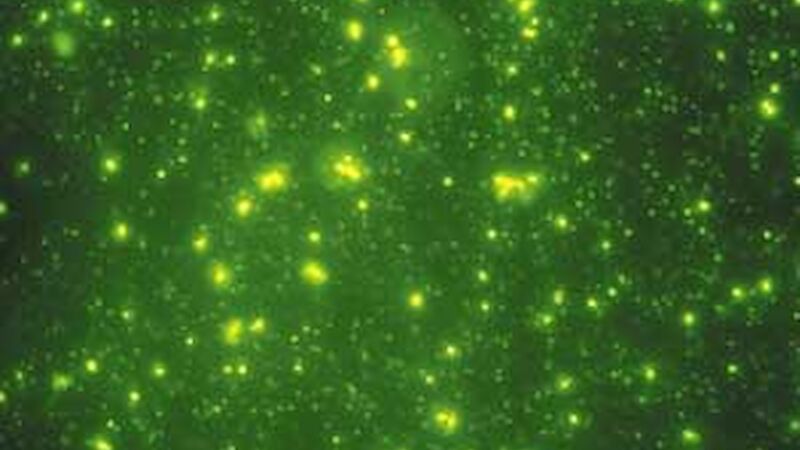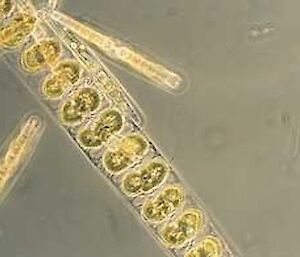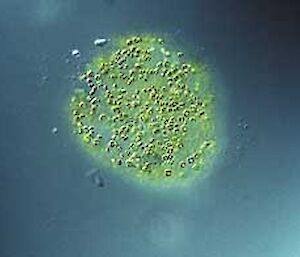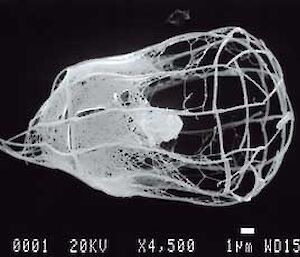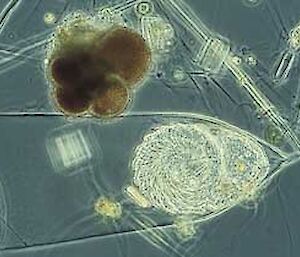The whales, seals, penguins and flying birds of Antarctica are well known and the subject of evocative images. They are Antarctic icons – the charismatic megafauna. However, by far the most abundant and globally important living things in Antarctica are the single-celled organisms – the phytoplankton (the single-celled floating plants), the protozoa (the single-celled animals), and bacteria that live in the sea. These microscopic critters hugely outnumber the macroscopic organisms (the ones you can see with the naked eye) in terms of species and abundance. They play a key role in the health, not just of the Southern Ocean, but of the planet.
These microscopic plants and animals range in size from around one micrometre (a thousandth of a millimetre) to about one tenth of a millimetre in size. Bacteria range in size from around a quarter of a micrometre to about a micrometre. Although they are very tiny there are a lot of them – what they lack in size they make up for in number. Every litre of seawater contains about one billion bacteria and around one million phytoplankton cells.
We know that the biomass of whales in the Southern Ocean is about five million tonnes. There are about 10 million tonnes of the six species of Antarctic seals and slightly less than one million tonnes of penguins. The krill population, on which these predators feed, is estimated to be between 60 and 155 million tonnes. In contrast, the biomass of the single-celled plants, the phytoplankton is estimated at around 5000 million tonnes in the Southern Ocean. In addition, there are some 1,200 million tonnes of bacteria and about 600 million tonnes of protozoa. In comparison, if all of us human beings on planet Earth stood on a weighbridge we would weigh in at around 160 million tonnes. In short, in the Southern Ocean the mass of microscopic plants, animals and bacteria is dramatically greater than that of the total all the macroscopic organisms.
Not only are the marine microorganisms very tiny and numerous, but they are highly diverse. We recognize around 400 species of phytoplankton and over 100 species of protozoa from the Southern Ocean.
We generally group the phytoplankton and protozoa together and call them protists because at the level of the single cell the differences between animals and plants get blurry. Many different kinds of phytoplankton can graze like protozoa, especially under low light conditions, and several different types of protozoa digest phytoplankton cells, except the chloroplasts (the site of photosynthetic activity) which they retain. These chloroplasts produce sugars which are used by their protozoan host.
Each species of microorganism, like the species of plants and animals that we can see with our naked eye, differs in size and shape and does different things in the ecosystem. Just as emperor penguins and Adélie penguins are different species, differ in size and shape and have very different strategies for feeding, breeding and generally going about their lives, so do different species of single celled animals. Similarly, just as different species of macroscopic plants differ in size, shape, means of reproduction, and food value to grazers, we find similar differences between microscopic plants.
Their main functions are:
- First, they're the food on which just about everything else in the sea ultimately depends. The single-celled plants are justifiably called the pasture of the ocean. They live in the top 100 metres or so of the ocean and just like their counterparts on land they use the energy of sunlight to produce carbohydrates in the process of photosynthesis. They are the direct equivalents in the sea of the trees, the bushes and the grass on land on which grazing animals depend. In the Southern Ocean, krill, copepods, salps and other grazers feed on phytoplankton and are they themselves prey for birds, mammals, fish and squid. No phytoplankton, then no krill, and no whales.
- Secondly, phytoplankton trap atmospheric carbon dioxide. Carbon dioxide from the atmosphere dissolves in the sea and is used by them. Most of this carbon dioxide that is turned into organic carbon by the algae is respired straight back to carbon dioxide again by the algae themselves and bacteria that use their excreted products. Only about 2% of the photoassimilated carbon is transported to the deep sea where it is out of circulation for centuries to thousands of years. The utilization of carbon dioxide by single-celled plants, the modification of this carbon by the marine micro-organisms and its vertical flux to the deep sea and sea floor is called the biological carbon pump. In these days of concern about the greenhouse effect and climate change, understanding how this biological carbon pump works and how hard this pump is working is of global significance. The process of photosynthesis by phytoplankton produces oxygen. We, and all the other oxygen-breathing animals, couldn’t survive without them.
- The third major function of marine microorganisms is a feedback to climate. Many of them produce sulphur-based chemicals which, when ventilated to the atmosphere, are modified to form sulphate aerosol particles. These aerosols can act as cloud condensation nuclei. The more cloud condensation nuclei the greater the cloudiness; the greater the cloudiness the greater the amount of solar radiation reflected back into space. A negative feedback loop has been proposed whereby the production of the sulphur compounds is enhanced by high light and increased temperature but increased cloudiness shades and lowers the temperature, reducing production of the sulphur based compounds.
The microscopic single-celled animals do all the sorts of things their larger macroscopic, visible, counterparts do. The herbivores eat plant material, the carnivores eat other animals and there are others that clean up the microscopic equivalents of carrion and detritus. So, just as is the case with large animals there are those that quietly graze and those that are voracious predators. In every drop of water there is a jungle with a similar struggle for survival. You just need a microscope to witness it. And yes, they do have sex.
The filter feeding group of protozoa called choanoflagellates illustrates the impact tiny, but very abundant, critters can have on the environment. They feed over a wide size range of particles. For them large food items are bacteria, about a quarter of their own size. They also ingest dissolved organic material, particles only a few tens of nanometres (One nanometer is a millionth of a millimetre) in size. In the Southern Ocean and off the coast of California choanoflagellates filter up to 10% of the surface water per day. In Danish coastal waters they filter about 25% of the surface waters. They play a vital role in trapping and repackaging carbon which will either be grazed by other animals or sink to great depths in the sea.
Next time you see Antarctic wildlife enjoy it, marvel at it and learn. But spare a thought for the microscopic creatures on which the whales, seals and birds ultimately depend. Picture in your mind’s eye a microscopic jungle teeming with life. The plants are doing all the sorts of things plants do – photosynthesizing, competing among themselves for light and space, and being grazed by animals. And among the plants lurk microscopic animals – some quietly grazing, others filtering goodies out of the water, and still others leaping out to devour the unwary. There is a jungle in every drop. Think about it too next time you go for a swim and get a mouthful.
For further information on Antarctic marine protists, including some videos of microbes swimming, go to Movement by Microbes.

